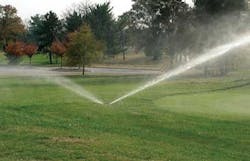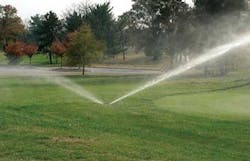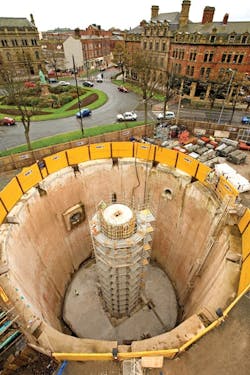Joinville, Orly See the Light
To comply with new regulations on pathogens and bromate restrictions, Degrémont Technologies-Ozonia has equiped the ozone drinking water treatment plants in Joinville and Orly, France, with Aquaray® H20 UV reactors. The addition of these ultraviolet light disinfection units upgrades the two ozone plants for the city of Paris and bring them to full compliance. With a capacity to treat 2 x 300.000 cubic meters a day (m³/d) of drinking water, the project is the largest drinking water UV contract in Europe.
Removal & Reduction
Levels of bromate ions in drinking water have recently come under scrutiny. These are commonly formed by the reaction between ozone and bromide ions, which are often naturally present in water.
The addition of UV disinfection units to ozone treatment plants, however, helps ensure only the safest and highest quality of water is delivered, and well under limits imposed by new regulations for both pathogen removal and bromate concentration reduction:
• The chosen UV reactors act as a final barrier in the disinfection process by inactivating pathogenic microorganisms like viruses, bacteria and parasites. Under proper conditions, UV lightwaves are particularly effective for inactivating chlorine-resistant microorganisms such as Cryptosporidium and Giardia, even at low doses.
• UV treated water also fully meets the new maximum limits for bromate concentrations, which were lowered to 10 μg/L (from 25 μg/L) in December 2008.
GAC filters-UV reactors area in the Joinville Plant
Retrofitting Challenges
Degrémont and Degrémont Technologies-Ozonia were selected not only for the efficiency of the Aquaray UV water disinfection reactors but also due to their long experience and ability to retrofit existing sites while maintaining full operation.
Careful consideration was given to the design and modeling of the UV reactors to guarantee compliance with the project's specifications and to the development of an installation plan that would keep the operation of the treatment lines already in place intact. The project consists of:
• Replacing the regulation valve,
• Adding a shut-off valve,
• Installing the UV reactors in the existing plant while minimizing head loss, after a functional analysis of the filters/UV reactor combination,
• Guaranteeing a dose of 40 mJ/cm², under the most unfavorable conditions (maximum flow, minimum transmittance).
After validation of the specific operating conditions at the Orly and Joinville sites by DENARD (Degremont North America Research and Development), the company developed highly-advanced hydraulic modeling parameters – based on computational fluid dynamics (CFD) using Fluent software – to precisely calculate and quantify the effects of hydraulic disturbances and pressure losses.
This preliminary study demonstrated that installation of these inline cross flow UV reactors would have no significant impact on the hydraulics of the plant and, given the low pressure losses, they could be easily retrofitted to the main piping system, at the outlet of the activated carbon filters.
The study also established the DN 500 diameter as the most appropriate choice for the plants. The reactor/valve combination guarantees the specified head loss and performance of the hydraulic regulation.
"The CFD modeling step was crucial and confirmed our UV reactors could be installed without any negative impact on the activated carbon filters. The technical teams of SAGEP and Degrémont greatly contributed to success of this project through active collaboration," said Vincent Pilmis, Degrémont Technologies-Ozonia project manager.
Proven and Recognized
UV treatment doesn't alter the physiochemical characteristics of the water. Bioassays, or biological tests, conducted on specific organisms in an operating plant provide the only ultimate validation of the effectiveness of these UV medium pressure reactors.
The Aquaray H20 UV water disinfection reactors (20" Mono and 20" Duplex) are certified by the German Technical and Scientific Association for Gas and Water (DVGW) and the U.S. Environmental Protection Agency (EPA), and guarantee consistent compliance with the prescribed amount of 40 mJ/cm² defined in conjunction with the Paris water management company, Société Anonyme de Gestion des Eaux de Paris (SAGEP). In addition, in France, when used to prevent parasitic risks, UV treatment solutions must be approved by the French Ministry of Health.
Currently, Degrémont Technologies-Ozonia is the only manufacturer to have obtained this approval for this specific range, following a recommendation from the French Food Safety Agency (AFSSA) to manage the flow rates such as those treated by these two 20" UV reactor ranges.
Reliability in a Small Footprint
These UV reactors use high density medium pressure lamps to offer a compact footprint and reduce capital costs. Powered by electronic ballasts, these lamps are inserted in pure quartz sleeves isolating them from the water. They can be easily changed without draining the reactor and, due to the variable output ballast, total power can be adjusted on demand. Moreover, a dedicated and calibrated UV sensor is installed for each lamp to monitor UV intensity and ensure optimum reliability.
Engineered with advanced CFD modeling software to determine the optimal lamp spacing, the system provides consistent and reliable disinfection with a minimum of head loss.
As a result, the powerful dose of UV light delivered requires fewer lamps. Only six UV lamps were needed in the reactor for Joinville and 12 lamps for Orly to achieve a production of 300.000 m³/d. This significantly decreases operating and maintenance costs.
Conclusion
The Aquaray H2O UV reactor offers a compact footprint and easy integration in new or existing water treatment lines and the easy access to all components ensures rapid and trouble-free maintenance.
With offices in Switzerland, North America, France, Japan, Korea, Russia and the UK, Degrémont Technologies-Ozonia has a long history and extensive experience with UV and ozone technologies, and supplies both industrial and municipal sectors. Degrémont Technologies is the worldwide dedicated equipment branch of Degrémont, the water and wastewater specialist of Suez Environnement active in over 70 countries with nearly 4,600 employees worldwide. Contact: [email protected] or www.degremont-technologies.com
More Water & WasteWater International Current Issue Articles
More Water & WasteWater International Archives Issue Articles



